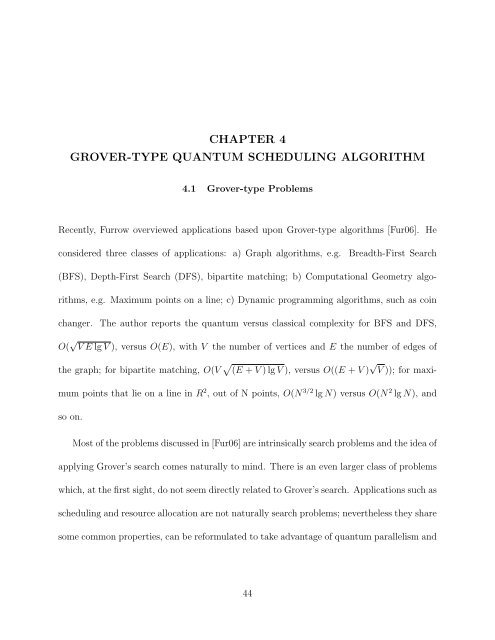t b a b a
t b a b a
t b a b a
Create successful ePaper yourself
Turn your PDF publications into a flip-book with our unique Google optimized e-Paper software.
CHAPTER 4<br />
GROVER-TYPE QUANTUM SCHEDULING ALGORITHM<br />
4.1 Grover-type Problems<br />
Recently, Furrow overviewed applications based upon Grover-type algorithms [Fur06]. He<br />
considered three classes of applications: a) Graph algorithms, e.g. Breadth-First Search<br />
(BFS), Depth-First Search (DFS), bipartite matching; b) Computational Geometry algo-<br />
rithms, e.g. Maximum points on a line; c) Dynamic programming algorithms, such as coin<br />
changer. The author reports the quantum versus classical complexity for BFS and DFS,<br />
O( √ V E lg V ), versus O(E), with V the number of vertices and E the number of edges of<br />
the graph; for bipartite matching, O(V � (E + V ) lg V ), versus O((E + V ) √ V )); for maxi-<br />
mum points that lie on a line in R 2 , out of N points, O(N 3/2 lg N) versus O(N 2 lg N), and<br />
so on.<br />
Most of the problems discussed in [Fur06] are intrinsically search problems and the idea of<br />
applying Grover’s search comes naturally to mind. There is an even larger class of problems<br />
which, at the first sight, do not seem directly related to Grover’s search. Applications such as<br />
scheduling and resource allocation are not naturally search problems; nevertheless they share<br />
some common properties, can be reformulated to take advantage of quantum parallelism and<br />
44

















